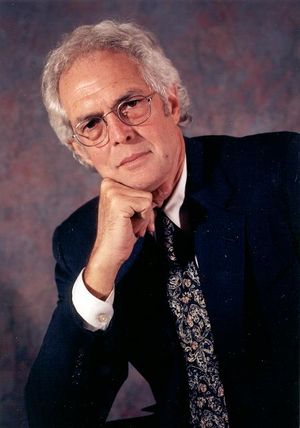Thomas Cover: Difference between revisions
(Created page with "== Biography == Born: August 7th, 1938 Died: March 26th, 2012 thumb|right Thomas Cover was born on August 7th, 1938 in San Bernardino, Cali...") |
No edit summary |
||
| (4 intermediate revisions by 2 users not shown) | |||
| Line 1: | Line 1: | ||
{{Biography | |||
|Image=Thomas M. Cover 2382.jpg | |||
|Birthdate=1938/08/07 | |||
|Birthplace=San Bernardino, CA, USA | |||
|Death date=2012/03/26 | |||
|Associated organizations=Stanford University | |||
[[ | |Fields of study=Information theory | ||
|Awards=[[IEEE Richard W. Hamming Medal]] | |||
}} | |||
Thomas Cover was born on August 7th, 1938 in San Bernardino, California. He received his B.S. in physics from MIT in 1960 and received his M.S. and Ph.D. in electrical engineering from Stanford in 1961 and 1964, and joined the faculty at the Stanford School of Engineering. He became a professor in 1972 and directed Stanford's Information Systems Laboratory from 1988 to 1996. | Thomas Cover was born on August 7th, 1938 in San Bernardino, California. He received his B.S. in physics from MIT in 1960 and received his M.S. and Ph.D. in electrical engineering from Stanford in 1961 and 1964, and joined the faculty at the Stanford School of Engineering. He became a professor in 1972 and directed Stanford's Information Systems Laboratory from 1988 to 1996. | ||
| Line 15: | Line 16: | ||
With Joy A. Thomas, Cover co-wrote ''Elements of Information Theory'', which is to be a classic text in the information theory discipline. Cover also served as past president of the [[IEEE Information Theory Society History|IEEE Information Theory Society]], and was awarded the society's Claude E. Shannon Award in 1990. In 1997, he was awarded the [[IEEE Richard W. Hamming Medal]] for "fundamental work in information theory, statistics and pattern recognition." | With Joy A. Thomas, Cover co-wrote ''Elements of Information Theory'', which is to be a classic text in the information theory discipline. Cover also served as past president of the [[IEEE Information Theory Society History|IEEE Information Theory Society]], and was awarded the society's Claude E. Shannon Award in 1990. In 1997, he was awarded the [[IEEE Richard W. Hamming Medal]] for "fundamental work in information theory, statistics and pattern recognition." | ||
[[Category:Information theory | [[Category:Information theory]] | ||
{{DEFAULTSORT:Cover}} | |||
Latest revision as of 18:30, 29 February 2016
- Birthdate
- 1938/08/07
- Birthplace
- San Bernardino, CA, USA
- Death date
- 2012/03/26
- Associated organizations
- Stanford University
- Fields of study
- Information theory
- Awards
- IEEE Richard W. Hamming Medal
Biography
Thomas Cover was born on August 7th, 1938 in San Bernardino, California. He received his B.S. in physics from MIT in 1960 and received his M.S. and Ph.D. in electrical engineering from Stanford in 1961 and 1964, and joined the faculty at the Stanford School of Engineering. He became a professor in 1972 and directed Stanford's Information Systems Laboratory from 1988 to 1996.
In 1973, Cover formulated the concept of superposition of signals in broadcast channels, which made the simultaneous transmission of information from one transmitter to several receivers possible. His work in this area was extremely influential on data compression algorithms which were used in wireless communications, and his "Nearest-Neighbor Rule" was foundational to the theory of pattern recognition.
Cover expressed interest in gaming theory and gambling strategies, and while still on the faculty at Stanford, served as a contractor to the California State Lottery from 1986 to 1994 where he designed tests for lottery balls and wheels and analyzed the payoff structure of games. In order to anticipate and combat fraud, he devised ways of beating the lottery to make the games more secure.
With Joy A. Thomas, Cover co-wrote Elements of Information Theory, which is to be a classic text in the information theory discipline. Cover also served as past president of the IEEE Information Theory Society, and was awarded the society's Claude E. Shannon Award in 1990. In 1997, he was awarded the IEEE Richard W. Hamming Medal for "fundamental work in information theory, statistics and pattern recognition."
